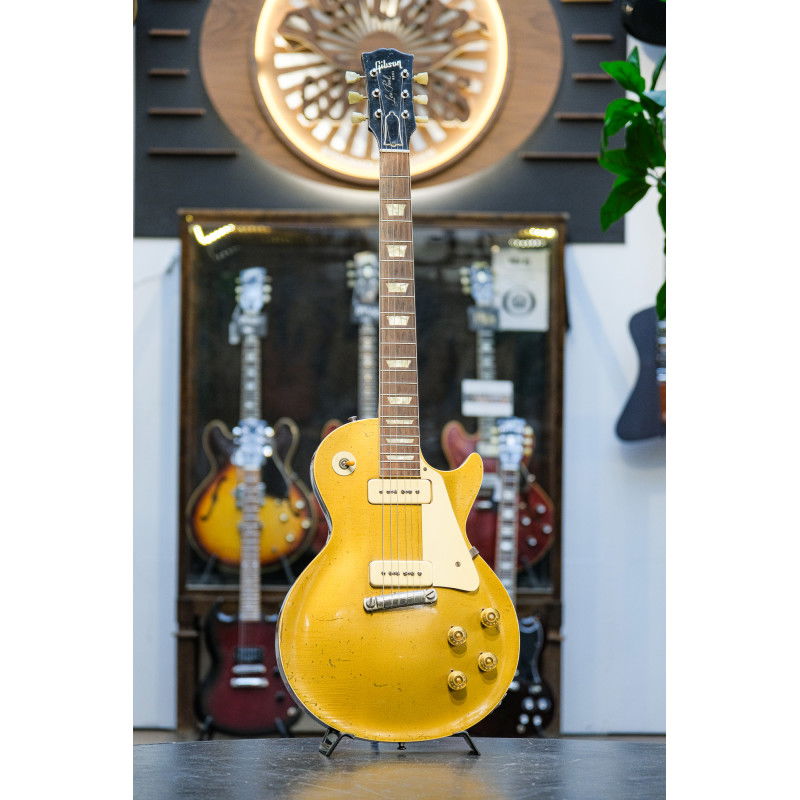
1953 Gibson Les Paul goldtop
495 000,00 kr
(inkl. moms)
Made in USA
Very Good condition, 7,5/10, Made in Kalamazoo, MI, USA, including original brown 4-latch Lifton hardcase, and absolutely super light weight (3,56kg / 8.05lbs) as anything at 8,5lbs or under would be considered feather weight in the LP-world. Caught your interest? Read on.
This is an early wraparound Goldtop as the transition from trapeze tailpiece to wrap-around on the 1953 Les Paul started at earliest around serial number "3 13xx" (so early 1953 models still use the older trapeze tailpiece) and since this guitar is 3 2397 it was built right when this transition was done by Gibson, the cover to the electronics cavity has a sticker on the inside from Guitar Trader in Red Bank, NJ where this guitar was purchased around 1978 by the previous owner who had his own guitar store in Malmö, Sweden called Straton Music (Föreningsgatan 52, Specialist på gamla Fender/Gibson), the previous owner has engraved his personal number in the neck heel
Lots of specs will follow including some history lessons for those who are interested:
-beautiful deep carve in the top
-light checking all over
-no breaks or repairs
-untouched solder throughout and all original parts except for the output jack plate that has been replaced with a home made metal plate and the tuners (more info on those below, the originals would have been Kluson no line), so 2 parts that can be sourced with some work but we leave that to the next owner
-original knobs (the gold barrel-shaped knobs on 1953 stopbar Les Pauls are shorter than the knobs used on the earlier trapeze model)
-correct thin ear wraparound bridge (used on 1953 and early ‘54 Goldtops, by late ‘54 the thin eared bridges were phased out for the standard wraparound seen on ‘54 and ‘55 Goldtops, and all Juniors/Specials of the 50s) and 1/2" bushings that are naturally leaning a bit forward as always on these early Les Pauls (the posts and bushings on Gibson Les Paul guitars from this time period are shorter than posts and bushings used after 1956. Gibson deepened the amount of post set in the body in order to gain leverage so that the post wouldn't begin to lean under constant string tension),
-correct early style 1950´s 3-way switch
-1 piece (nice and light!) mahogany body with 3 piece carved maple top (took us a while to see the seams in the top but in the reflections of the light it can be seen)
-typical mid 1953 cavity with small output channel route
-original pickguard, Catalin switchtip and poker chip
-2pc correct P90 pickups which measure 7,66kOhm (bridge) and 8,13kOhm (neck)
-old style and now unused trapeze string ground channel as Gibson was using up the existing stock of trapeze-era mahogany body backs and the grounding wire is instead run to the high E stud from the bridge pickup cavity where it is wrapped around the pickup braided wire and soldered
-original frets with only slight fretwear
-the Centralab pots are dated 134323 (23rd week of 1953)
-untouched electronics with 2pc paper in oil Grey Tiger capacitors (the most common capacitors in early to mid 1950´s Les Pauls and other Gibsons)
-3-strand braided wire in the electronics (some sources online have written that only 2-strand wire was used into the 1960´s but that is not true, here is an example, we can show others as well if you are interested)
-truss rod cover with roll marks
-more info on the tuners that perhaps was taken from the "good parts" bin at Guitar Trader; 3pc nickel single line Kluson Deluxe typical of mid-1956 to late-1958 with 2356766 PAT. APPLD. stamped underneath, 1pc double line nickel Kluson Deluxe tuner typical of late-1958 to mid-1960 with D-169400 PATENT NO stamped underneath (and 1pc exactly the same with deteriorated tip in the case), 1pc double line gold Kluson Deluxe tuner typical of late-1958 to mid-1960 with D-169400 PATENT NO stamped underneath, and one modern Kluson Deluxe with no stamps underneath
It would probably have saved me time to instead of writing all this just put on a set of modern tuners and keep these but I like selling the guitar as it came to us as it is part of it´s history so now you know everything.







































































































































































































































































































































































































































































































































































































































































































































